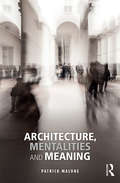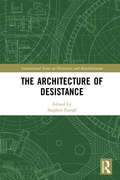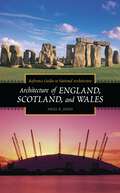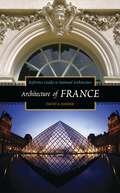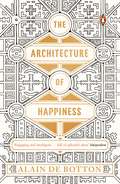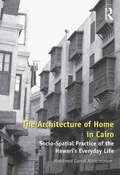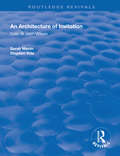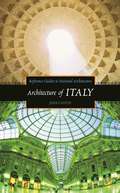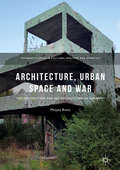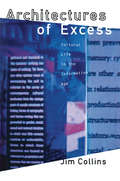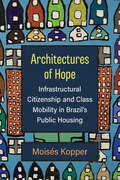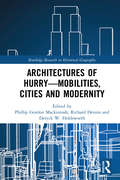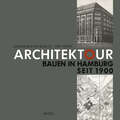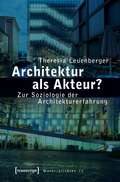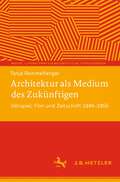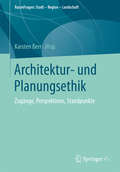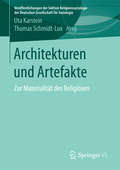- Table View
- List View
Architecture, Mentalities and Meaning
by Patrick MaloneIn order to function, architectural theory and practice must be shaped to suit current cultural, economic, and political forces. Thus, architecture embodies reductive logic that conditions the treatment of human and social processes – which raises the question of how to define objectivity for architectural mentalities that must conform to a set of immediate conditions. This book focuses on meaning, and on the physical and mental processes that define life in built environments. The potential to draw knowledge from aesthetics, psychology, political economy, philosophy, geography, and sociology is offset by the fact that architectural logic is inevitably reductive, cultural, socio-economic, and political. However, despite the duty to conform, it is argued that the treatment of human processes, and the understanding of architectural mentalities, can benefit from interdisciplinary linkages, small freedoms, and cracks in a system of imperatives that can yield the means of greater objectivity. This is valuable reading for students and researchers interested in architectural theory as a working reality, and in the relationships between architecture and other fields.
Architecture, Mentalities and Meaning
by Patrick MaloneIn order to function, architectural theory and practice must be shaped to suit current cultural, economic, and political forces. Thus, architecture embodies reductive logic that conditions the treatment of human and social processes – which raises the question of how to define objectivity for architectural mentalities that must conform to a set of immediate conditions. This book focuses on meaning, and on the physical and mental processes that define life in built environments. The potential to draw knowledge from aesthetics, psychology, political economy, philosophy, geography, and sociology is offset by the fact that architectural logic is inevitably reductive, cultural, socio-economic, and political. However, despite the duty to conform, it is argued that the treatment of human processes, and the understanding of architectural mentalities, can benefit from interdisciplinary linkages, small freedoms, and cracks in a system of imperatives that can yield the means of greater objectivity. This is valuable reading for students and researchers interested in architectural theory as a working reality, and in the relationships between architecture and other fields.
The Architecture of Desistance (International Series on Desistance and Rehabilitation)
by Stephen FarrallThe volume of studies into desistance has grown dramatically in recent years. Much of this research has focused on the internal dynamics of desistance such as decision-making, choice and restraint. Bringing together leading figures and drawing upon case studies from around the world, this book seeks to fill a vacuum in the contemporary literature on desistance by considering processes and practices at a societal level that influence how and why people desist from crime. Beginning with an outline of what is known about how social, cultural and economic structures shape desistance from crime, this book proceeds to explore studies of desistance in countries such as the UK, Brazil, France, Israel, Ireland, Sweden and Chile. These studies touch on variations by ethnicity, the nature of the criminal justice system, economic cycles, gender, religious belief systems and the use of time and space. Policy matters relating to desistance such as the rehabilitation and supervision of former offenders are also explored. This book will be invaluable reading to students and scholars of criminology, sociology and social studies engaged in studies of desistance, criminology, criminal justice, victimology, penology and probation.
The Architecture of Desistance (International Series on Desistance and Rehabilitation)
by Stephen FarrallThe volume of studies into desistance has grown dramatically in recent years. Much of this research has focused on the internal dynamics of desistance such as decision-making, choice and restraint. Bringing together leading figures and drawing upon case studies from around the world, this book seeks to fill a vacuum in the contemporary literature on desistance by considering processes and practices at a societal level that influence how and why people desist from crime. Beginning with an outline of what is known about how social, cultural and economic structures shape desistance from crime, this book proceeds to explore studies of desistance in countries such as the UK, Brazil, France, Israel, Ireland, Sweden and Chile. These studies touch on variations by ethnicity, the nature of the criminal justice system, economic cycles, gender, religious belief systems and the use of time and space. Policy matters relating to desistance such as the rehabilitation and supervision of former offenders are also explored. This book will be invaluable reading to students and scholars of criminology, sociology and social studies engaged in studies of desistance, criminology, criminal justice, victimology, penology and probation.
Architecture of England, Scotland, and Wales (Reference Guides to National Architecture)
by Nigel R. JonesThe British terrain is a gold mine for the student of architecture. Ranging in era from ancient times to the present day—from Stonehenge to the Millennium Dome—this volume's 76 entries include palaces, castles, bridges, churches, country houses, and various public buildings and monuments, as well as such well-known features of British architecture and design as terraced houses, suburban semi-detached houses, and public telephone kiosks. Detailed yet accessible to nonspecialist readers, the alphabetical entries also provide cross-references and lists of additional information sources in both print and electronic formats. Appendixes list the entries by location, architectural style, and architect/designer; explain the defining characteristics of major British architectural styles; and discuss the importance of the Crown, peerage, and Parliament in British architectural history. Besides a detailed subject index, the volume includes a timeline, a general bibliography, a glossary of architectural terms, and an introduction that traces the development of British architecture from prehistoric and Roman times to the 21st century.Written by an associate professor of architecture at Oklahoma State University, Architecture of England, Scotland, and Wales, part of Greenwood's Reference Guides to National Architecture series, presents architectural biographies of these countries' most famous and significant structures.
Architecture of France (Reference Guides to National Architecture)
by David A. HanserCovering all regions of France—from Avignon's Palace of the Popes to Versailles' Petit Trianon—and all periods of French architecture—from the Roman theater at Orange to the Arc de Triomphe in Paris—this volume examines more than 60 of France's most important architectural landmarks. Writing in a clear and engaging style, David Hanser, professor of architecture at Oklahoma State University, describes the features, functions, and historical importance of each structure. Besides identifying location, style, architects, and periods of initial construction and major renovation, the cross-referenced and illustrated entries also highlight architectural and historical terms explained in the Glossary and conclude with a useful listing of further readings. The volume also offers ready-reference lists of entries by location, architectural style, and time period, as well as a general bibliography, a subject index, and a detailed introductory overview of French architecture.Entries cover major architectural structures as well as smaller sites, including everything from the Cathedral of Notre Dame to Metro (subway) stations. Ideal for college and high school students alike, this comprehensive look at the architecture of France is an indispensible addition to any shelf.
The Architecture of Happiness: The Architecture Of Happiness (Vintage International Series)
by Alain De BottonThe Architecture of Happiness is Alain de Botton's exploration of the hidden links between buildings and our well beingBestselling author Alain de Botton has written about love, travel, status and how philosophy can console us. Now he turns his attention to one of our most intense but often hidden love affairs: with our houses and their furnishings. He asks: What makes a house truly beautiful?Why are many new houses so ugly?Why do we argue so bitterly about sofas and pictures - and can differences of taste ever be satisfactorily resolved?Will minimalism make us happier than ornaments? To answer these questions and many more, de Botton looks at buildings across the world, from medieval wooden huts to modern skyscrapers; he examines sofas and cathedrals, tea sets and office complexes, and teases out a host of often surprising philosophical insights. The Architecture of Happiness will take you on a beguiling tour through the history and psychology of architecture and interior design, and will forever alter your relationship with buildings. It will change the way you look at your current home - and help you make the right decisions about your next one.'Engaging and intelligent . . . full of splendid ideas, happily and beautifully expressed'IndependentAlain de Botton was born in 1969 and is the author of non-fiction essays on themes ranging from love and travel to architecture and philosophy. His bestselling books include Essays in Love; The Romantic Movement; Kiss and Tell; Status Anxiety; How Proust Can Change Your Life; The Pleasures and Sorrows of Work; The Art of Travel; The Architecture of Happiness and Religion for Atheists. He lives in London and founded The School of Life (www.theschooloflife.com) and Living Architecture (www.living-architecture.co.uk). For more information, consult www.alaindebotton.com.
The Architecture of Home in Cairo: Socio-Spatial Practice of the Hawari's Everyday Life
by Mohamed Gamal AbdelmonemThe hawari of Cairo - narrow non-straight alleyways - are the basic urban units that have formed the medieval city since its foundation back in 969 AD. Until early in the C20th, they made up the primary urban divisions of the city and were residential in nature. Contemporary hawari, by contrast, are increasingly dominated by commercial and industrial activity. This medieval urban maze of extremely short, broken, zigzag streets and dead ends are defensible territories, powerful institutions, and important social systems. While the hawari have been studied as an exemplar for urban structure of medieval Islamic urbanism, and as individual building typologies, this book is the first to examine in detail the socio-spatial practice of the architecture of home in the city. It investigates how people live, communicate and relate to each other within their houses or shared spaces of the alleys, and in doing so, to uncover several new socio-spatial dimensions and meanings in this architectural form. In an attempt to re-establish the link between architecture past and present, and to understand the changing social needs of communities, this book uncovers the notion of home as central to understand architecture in such a city with long history as Cairo. It firstly describes the historical development of the domestic spaces (indoor and outdoor), and provides an inclusive analysis of spaces of everyday activities in the hawari of old Cairo. It then broadens its analysis to other parts of the city, highlighting different customs and representations of home in the city at large. Cairo, in the context of this book, is represented as the most sophisticated urban centre in the Middle East with different and sometimes contrasting approaches to the architecture of home, as a practice and spatial system. In order to analyse the complexity and interconnectedness of the components and elements of the hawari as a 'collective home', it layers its narratives of architectural and social developments as a domestic environment over the past two hundred years, and in doing so, explores the in-depth social meaning and performance of spaces, both private and public.
The Architecture of Home in Cairo: Socio-Spatial Practice of the Hawari's Everyday Life
by Mohamed Gamal AbdelmonemThe hawari of Cairo - narrow non-straight alleyways - are the basic urban units that have formed the medieval city since its foundation back in 969 AD. Until early in the C20th, they made up the primary urban divisions of the city and were residential in nature. Contemporary hawari, by contrast, are increasingly dominated by commercial and industrial activity. This medieval urban maze of extremely short, broken, zigzag streets and dead ends are defensible territories, powerful institutions, and important social systems. While the hawari have been studied as an exemplar for urban structure of medieval Islamic urbanism, and as individual building typologies, this book is the first to examine in detail the socio-spatial practice of the architecture of home in the city. It investigates how people live, communicate and relate to each other within their houses or shared spaces of the alleys, and in doing so, to uncover several new socio-spatial dimensions and meanings in this architectural form. In an attempt to re-establish the link between architecture past and present, and to understand the changing social needs of communities, this book uncovers the notion of home as central to understand architecture in such a city with long history as Cairo. It firstly describes the historical development of the domestic spaces (indoor and outdoor), and provides an inclusive analysis of spaces of everyday activities in the hawari of old Cairo. It then broadens its analysis to other parts of the city, highlighting different customs and representations of home in the city at large. Cairo, in the context of this book, is represented as the most sophisticated urban centre in the Middle East with different and sometimes contrasting approaches to the architecture of home, as a practice and spatial system. In order to analyse the complexity and interconnectedness of the components and elements of the hawari as a 'collective home', it layers its narratives of architectural and social developments as a domestic environment over the past two hundred years, and in doing so, explores the in-depth social meaning and performance of spaces, both private and public.
An Architecture of Invitation: Colin St John Wilson (Routledge Revivals)
by Sarah Menin Stephen KiteFirst published in 2005, An Architecture of invitation: Colin St John Wilson is a distinctive study of the life and architectural career of one of the most significant makers, theorists and teachers of architecture to have emerged in England in the second half of the twentieth century. Exceptionally in an architectural study, this book interweaves biography, critical analysis of the projects, and theory, in its aims of explicating the richness of Wilson’s body of work, thought and teaching. Drawing on the specialisms of its authors, it also examines the creative and psychological impulses that have informed the making of the work – an oeuvre whose experiential depth is recognised by both users and critics.
An Architecture of Invitation: Colin St John Wilson (Routledge Revivals)
by Sarah Menin Stephen KiteFirst published in 2005, An Architecture of invitation: Colin St John Wilson is a distinctive study of the life and architectural career of one of the most significant makers, theorists and teachers of architecture to have emerged in England in the second half of the twentieth century. Exceptionally in an architectural study, this book interweaves biography, critical analysis of the projects, and theory, in its aims of explicating the richness of Wilson’s body of work, thought and teaching. Drawing on the specialisms of its authors, it also examines the creative and psychological impulses that have informed the making of the work – an oeuvre whose experiential depth is recognised by both users and critics.
Architecture of Italy (Reference Guides to National Architecture)
by Jean CastexCovering all regions of Italy—from Turin's Palace of Labor in northern Italy to the Monreale Cathedral and Cloister in Sicily—and all periods of Italian architecture—from the first-century Colosseum in Rome to the Casa Rustica apartments built in Milan in the 1930s—this volume examines over 70 of Italy's most important architectural landmarks. Writing in an authoritative yet engaging style, Jean Castex, professor of architectural history at the Versailles School of Architecture, describes the features, functions, and historical importance of each structure. Besides idetifying location, style, architects, and periods of initial construction and major renovations, the cross-referenced and illustrated entries also highlight architectural and historical terms explained in the Glossay and conclude with a useful listing of further information resources. The volume also offers ready-reference lists of entries by location, architectural style, and time period, as well as a general bibliography, a detailed subject index, and a comprehensive introductory overview of Italian architecture.Entries cover major architectural structures as well as smaller sites, including everything from the well-known dome of St. Peter's at the Vatican to the Fiat Lingotto Plant in Turin. Ideal for college and high school students, as well as for interested general readers, this comprehensive look at the architecture of Italy is an indispensable addition to every architectural reference collection.
Architecture, Urban Space and War: The Destruction and Reconstruction of Sarajevo (Palgrave Studies in Cultural Heritage and Conflict)
by Mirjana RisticThis book investigates architectural and urban dimensions of the ethnic-nationalist conflict in Sarajevo, the capital of Bosnia and Herzegovina, during and after the siege of 1992–1995. Focusing on the wartime destruction of a portion of the cityscape in central Sarajevo and its post-war reconstruction, re-inscription and memorialization, the book reveals how such spatial transformations become complicit in the struggle for reconfiguration of the city’s territory, boundaries and place identity. Drawing on original research, the study highlights the capacities of architecture and urban space to mediate terror, violence and resistance, and to deal with heritage of the war and act a catalyst for ethnic segregation or reconciliation. Based on a multi-disciplinary methodological approach grounded in architectural and urban theory, the spatial turn in critical social theory and assemblage thinking, as well as techniques of spatial analysis, in particular morphological mapping, the book provides an innovative spatial framework for analyzing the political role of contemporary cities.
Architecture, Urban Space and War: The Destruction and Reconstruction of Sarajevo (Palgrave Studies in Cultural Heritage and Conflict)
by Mirjana RisticThis book investigates architectural and urban dimensions of the ethnic-nationalist conflict in Sarajevo, the capital of Bosnia and Herzegovina, during and after the siege of 1992–1995. Focusing on the wartime destruction of a portion of the cityscape in central Sarajevo and its post-war reconstruction, re-inscription and memorialization, the book reveals how such spatial transformations become complicit in the struggle for reconfiguration of the city’s territory, boundaries and place identity. Drawing on original research, the study highlights the capacities of architecture and urban space to mediate terror, violence and resistance, and to deal with heritage of the war and act a catalyst for ethnic segregation or reconciliation. Based on a multi-disciplinary methodological approach grounded in architectural and urban theory, the spatial turn in critical social theory and assemblage thinking, as well as techniques of spatial analysis, in particular morphological mapping, the book provides an innovative spatial framework for analyzing the political role of contemporary cities.
Architectures of Excess: Cultural Life in the Information Age
by Jim CollinsFirst Published in 1995. Much of recent theory has characterized life in media-sophisticated societies in terms of a semiotic overload which, allegedly, has had only devastating effects on communication and subjectivity. In Architectures of Excess, Jim Collins argues that, while the rate of technological change has indeed accelerated, so has the rate of absorption. The seemingly endless array of information has generated not chaos but different structures and strategies, which harness that excess by turning it into forms of art and entertainment. Digital sampling in rap music and cyber-punk science fiction are well-known examples of techno-pop textuality, but Collins concentrates on other contemporaneous phenomena that are also envisioning new cultural landscapes by accessing that array--hyper-self-reflexivity in mall movies, best sellers, and prime-time television; the deconstructive vs. new-classical debate in architecture; the emergence of the "New Black Aesthetic;" the development of retro-modernism in interior design and the fashion industries. The analyses of these disparate, discontinous attempts to develop a meaningful sense of location, in an historical as well as a spatial sense, address a cluster of interconnected questions: How is the array of information being "domesticated?" How has appropriationism evolved from the Pop-Art of the sixties to the sampling of the nineties? How has the relationship between tradition, innovation, and evaluation been altered? Architectures of Excess investigates how these phenomena reflect change in taste and subjectivity, considering how we must account for both, pedagogically.
Architectures of Excess: Cultural Life in the Information Age
by Jim CollinsFirst Published in 1995. Much of recent theory has characterized life in media-sophisticated societies in terms of a semiotic overload which, allegedly, has had only devastating effects on communication and subjectivity. In Architectures of Excess, Jim Collins argues that, while the rate of technological change has indeed accelerated, so has the rate of absorption. The seemingly endless array of information has generated not chaos but different structures and strategies, which harness that excess by turning it into forms of art and entertainment. Digital sampling in rap music and cyber-punk science fiction are well-known examples of techno-pop textuality, but Collins concentrates on other contemporaneous phenomena that are also envisioning new cultural landscapes by accessing that array--hyper-self-reflexivity in mall movies, best sellers, and prime-time television; the deconstructive vs. new-classical debate in architecture; the emergence of the "New Black Aesthetic;" the development of retro-modernism in interior design and the fashion industries. The analyses of these disparate, discontinous attempts to develop a meaningful sense of location, in an historical as well as a spatial sense, address a cluster of interconnected questions: How is the array of information being "domesticated?" How has appropriationism evolved from the Pop-Art of the sixties to the sampling of the nineties? How has the relationship between tradition, innovation, and evaluation been altered? Architectures of Excess investigates how these phenomena reflect change in taste and subjectivity, considering how we must account for both, pedagogically.
Architectures of Hope: Infrastructural Citizenship and Class Mobility in Brazil's Public Housing
by Moisés KopperArchitectures of Hope examines how communal idealism, electoral politics, and low-income consumer markets made first-time homeownership a reality for millions of low-income Brazilians over the last ten years. Drawing on a five-year-long ethnography among city planners, architects, street-level bureaucrats, politicians, market and bank representatives, community leaders, and past, present, and future beneficiaries, Moisés Kopper tells the story of how a group of grassroots housing activists rose from oblivion to build a model community. He explores the strategies set forth by housing activists as they waited and hoped for—and eventually secured—homeownership through Minha Casa Minha Vida’s public-private infrastructure. By showing how these efforts coalesced in Porto Alegre—Brazil’s once progressive hotspot—he interrogates the value systems and novel arrangements of power and market that underlie the country’s post-neoliberal project of modern and inclusive development. By chronicling the making and remaking of material hope in the aftermath of Minha Casa Minha Vida, Architectures of Hope reopens the future as a powerful venue for ethnographic inquiry and urban development.
Architectures of Hurry—Mobilities, Cities and Modernity (Routledge Research in Historical Geography)
by Phillip Gordon Mackintosh Richard Dennis Deryck W. Holdsworth‘Hurry’ is an intrinsic component of modernity. It exists not only in tandem with modern constructions of mobility, speed, rhythm, and time–space compression, but also with infrastructures, technologies, practices, and emotions associated with the experience of the ‘mobilizing modern’. ‘Hurry’ is not simply speed. It may result in congestion, slowing-down, or inaction in the face of over-stimulus. Speeding-up is often competitive: faster traffic on better roads made it harder for pedestrians to cross, or for horse-drawn vehicles and cyclists to share the carriageway with motorized vehicles. Focusing on the cultural and material manifestations of ‘hurry’, the book’s contributors analyse the complexities, tensions, and contradictions inherent in the impulse to higher rates of circulation in modernizing cities. The collection includes, but also goes beyond, accounts of new forms of mobility (bicycles, buses, underground trains) and infrastructure (street layouts and surfaces, business exchanges, and hotels) to show how modernity’s ‘architectures of hurry’ have been experienced, represented, and practised since the mid nineteenth century. Ten case studies explore different expressions of ‘hurry’ across cities and urban regions in Asia, Europe, and North and South America, and substantial introductory and concluding chapters situate ‘hurry’ in the wider context of modernity and mobility studies and reflect on the future of ‘hurry’ in an ever-accelerating world. This diverse collection will be relevant to researchers, scholars, and practitioners in the fields of planning, cultural and historical geography, urban history, and urban sociology.
Architectures of Hurry—Mobilities, Cities and Modernity (Routledge Research in Historical Geography)
by Phillip Gordon Mackintosh Richard Dennis Deryck W. Holdsworth‘Hurry’ is an intrinsic component of modernity. It exists not only in tandem with modern constructions of mobility, speed, rhythm, and time–space compression, but also with infrastructures, technologies, practices, and emotions associated with the experience of the ‘mobilizing modern’. ‘Hurry’ is not simply speed. It may result in congestion, slowing-down, or inaction in the face of over-stimulus. Speeding-up is often competitive: faster traffic on better roads made it harder for pedestrians to cross, or for horse-drawn vehicles and cyclists to share the carriageway with motorized vehicles. Focusing on the cultural and material manifestations of ‘hurry’, the book’s contributors analyse the complexities, tensions, and contradictions inherent in the impulse to higher rates of circulation in modernizing cities. The collection includes, but also goes beyond, accounts of new forms of mobility (bicycles, buses, underground trains) and infrastructure (street layouts and surfaces, business exchanges, and hotels) to show how modernity’s ‘architectures of hurry’ have been experienced, represented, and practised since the mid nineteenth century. Ten case studies explore different expressions of ‘hurry’ across cities and urban regions in Asia, Europe, and North and South America, and substantial introductory and concluding chapters situate ‘hurry’ in the wider context of modernity and mobility studies and reflect on the future of ‘hurry’ in an ever-accelerating world. This diverse collection will be relevant to researchers, scholars, and practitioners in the fields of planning, cultural and historical geography, urban history, and urban sociology.
Architektur als Akteur?: Zur Soziologie der Architekturerfahrung (Materialitäten #25)
by Theresia LeuenbergerErfahren Nutzer_innen Gebäude so, wie es sich die Architekt_innen vorgestellt haben? Fühlen sie sich »eingeladen« oder eher »ausgeschlossen«? Mit theoretischen Grundlagen aus Raumsoziologie, Praxistheorie und Akteur-Netzwerk-Theorie definiert und untersucht Theresia Leuenberger Architekturerfahrungen anhand des Kunsthaus Bregenz und der Kunsthal Rotterdam. Mit der Methode der Rekonstruktiven Sozialforschung zeigt sie, wie emotionale und rationale Gehalte von Erfahrungen aufeinander einwirkend Praktiken der Architekturerfahrung konstituieren. Dabei stellt sich heraus, dass diese nur bei übereinstimmenden Subjektpositionen oder im Falle einer Vorzeichnung durch das Gebäude den Vorstellungen der Architekten Peter Zumthor und Rem Koolhaas gleichen.
Architektur als Medium des Zukünftigen: Hörspiel, Film und Zeitschrift 1945–1955 (Media. Literaturwissenschaftliche Forschungen)
by Tanja RommelfangerDas Buch beschäftigt sich mit der Architektur der unmittelbaren Nachkriegszeit als Gegenstand medialer Repräsentation. Dabei bewegt es sich im Spannungsfeld von Germanistik, Architekturgeschichte und Medienwissenschaft. Anhand von Radiohörspielen, Architekturzeitschriften und Filmen geht es der Frage nach, wie Architektur in Szene gesetzt wird. Dabei bezieht die Analyse mit ein, wie diese im Hinblick auf die Konstruktion und den Aufbau einer neuen Zukunft mit bestehenden Diskursen der Moderne in Verbindung gebracht wird und problematische Bezüge zur nationalsozialistischen Vergangenheit aufweist. In Werken von Günter Eich (Träume, 1951), Otto Renner (BAU. Zeitschrift für wohnen, arbeiten, sich erholen, 1947) und mit einem anonymen Städtefilm (Stein auf Stein. Ein Land baut auf, 1949) werden wenig bekannte Kurzformen aufgegriffen, um deren Verknüpfung mit neuen Medienverbunden und soziopolitischen Diskursen zu erforschen. Die detaillierten Analysen - von Eichs „Fünftem Traum“ als Mediengeflecht von Text, Musik und Geräusch, der heute wenig bekannten, aber zu ihrer Zeit renommierten Architekturzeitschrift BAU als Medienverbund aus zirkulierenden und wiederaufbereiteten Fotografien, Zeichnungen, Texten und Typografie und dem Kurzfilm Stein auf Stein mit seinen intermedialen Bezügen u.a. zur Fotografie - stellen Querverbindungen zu vielen Figuren und Werken dieser Zeit her, in der die Architektur eine Neubewertung als vermittelnde Instanz zwischen Individuum und Gesellschaft erfährt.Davon ausgehend schließt die Autorin auf größere Problematiken, die die Öffentlichkeit in den frühen Nachkriegsjahren beschäftigten. Dabei weist sie Momente des Exzesses und der Überschreitung in den Werken auf, die in einer Zeit der Ressourcenknappheit, Medienregulierung und konfliktreicher Lizensierungspolitik entstanden sind. Auch der Umbruch im Mediengefüge durch die Einführung von Fernsehen und die moralisch aufgeladene Debatte über eine entnazifizierte Öffentlichkeit werden reflektiert. Das Buch geht auch ausführlich auf die Besatzungspolitik im teilautonomen Saarland ein und führt die französische Kolonialpolitik in Algerien indirekt über die Rezeption Le Corbusiers in den deutschen Diskurs ein.Das Buch richtet sich an Studierende und Forschende der Fachgebiete Literatur-, Medien- und Kulturwissenschaft, Kunstgeschichte und Architektur.
Architektur- und Planungsethik: Zugänge, Perspektiven, Standpunkte (RaumFragen: Stadt – Region – Landschaft)
by Karsten BerrDie Autoren dieses Bandes eröffnen Zugänge, Perspektiven und Standpunkte zu einer Architektur- und Planungsethik für Menschen in einer bebauten und bewohnten Welt, die auch in Zukunft bewohnbar bleiben soll. Den Beiträgen ist gemeinsam, dass sie von einer konkreten Praxis ausgehen und zeigen, welche ethisch relevanten Aspekte mit dem Handeln der Akteure verbunden sind oder mit welchen moralischen Herausforderungen dieses Handeln konfrontiert wird. In einem ersten Zugriff werden Zugänge zu moralischen, ethischen und politischen Aspekten der Planung identifiziert und für weitere architektur- und planungsethische Überlegungen erschlossen. Anschließend werden grundlegende begriffliche und theoretische Perspektiven einer Architektur- und Planungsethik aus lebensweltlichen Erfahrungen oder Handlungen der Akteure oder der Eigenlogik architektonischer Entwurfs- und Planungsprozesse entwickelt. Abschließend wird das heikle Verhältnis des Ästhetischen und Moralischen innerhalb architektur- und planungsethischer Überlegungen begrifflich präzisiert und mit neuen Argumenten gewichtet.
Architekturen und Artefakte: Zur Materialität des Religiösen (Veröffentlichungen der Sektion Religionssoziologie der Deutschen Gesellschaft für Soziologie)
by Uta Karstein Thomas Schmidt-LuxIn der Soziologie ist seit längerer Zeit ein zunehmendes Interesse an Architektur und Artefakten beobachtbar. Dabei wird daran erinnert, dass nicht nur immaterielle Zeichen, Symbole und Repräsentationen des Sozialen existieren, sondern auch Orte, Stoffe und Dinge. Diesen wird eine wichtige Rolle im sozialen Geschehen zugesprochen: Materiales erscheint als Träger von Erinnerungskulturen, als sozialer Akteur, Heilsvermittler, Medium von Repräsentation – kurz: als Bedingung, Beschränkung und Instrument sozialer Praxis. Dies gilt auch in Bezug auf Religion. Dennoch hat die Perspektive noch kaum Eingang in die deutschsprachige Religionssoziologie gefunden. Dieser Band soll daher Anstoß sein für die Öffnung der Religionssoziologie in Richtung einer Soziologie des Materialen.
Architektursoziologie: Grundlagen - Epochen - Themen (Uni-Taschenbücher #8254)
by Bernhard SchäfersDiese Einführung vermittelt in drei Großkapiteln die Grundlagen einer Soziologie der Architektur, liefert einen Überblick über die Epochen seit 1800 und beschreibt die Themen- und Praxisfelder. Dies ist der erste Band der zweibändigen Soziologie der Architektur und der Stadt.
